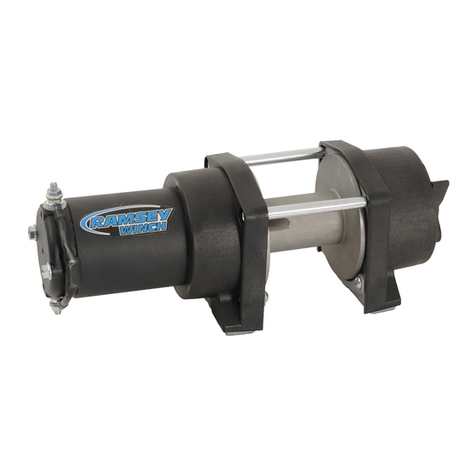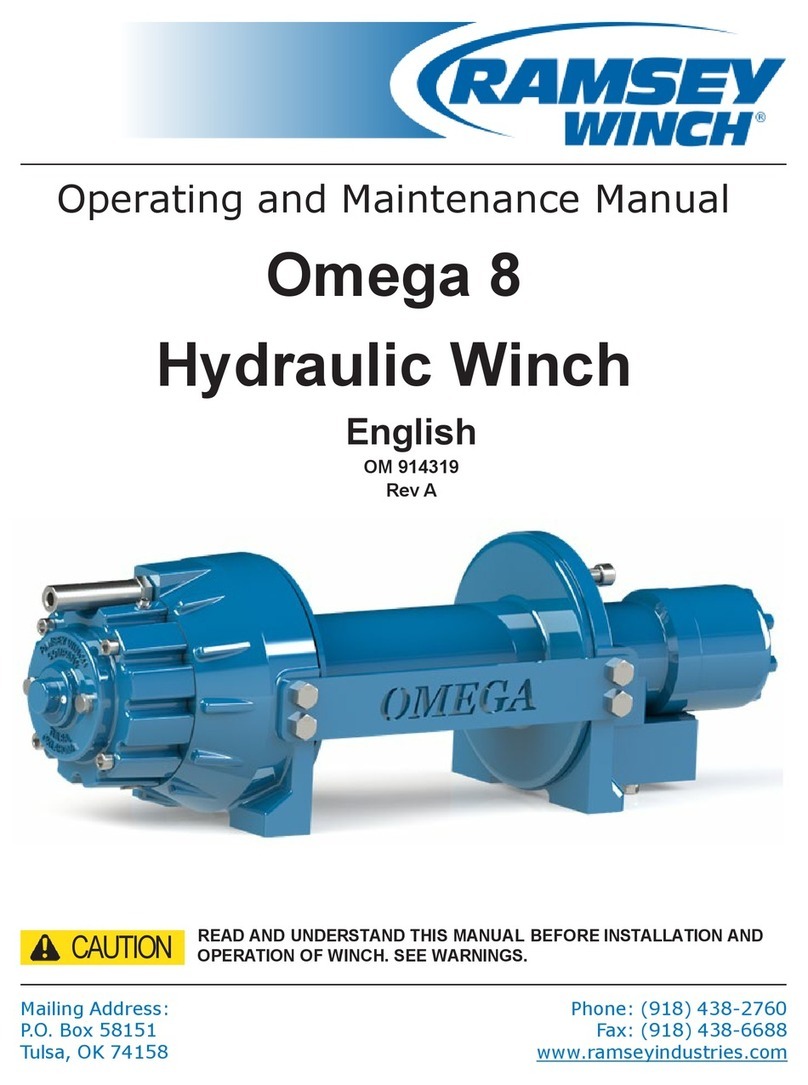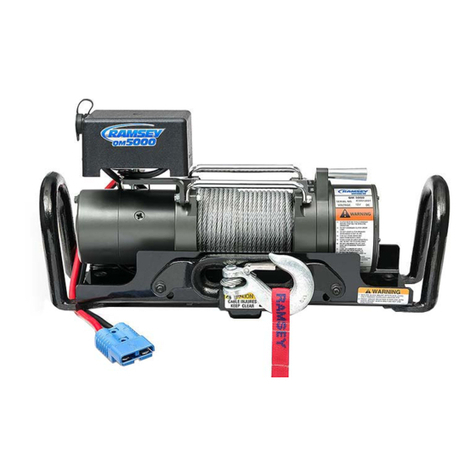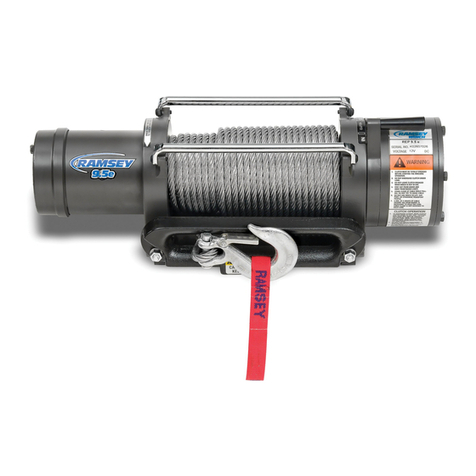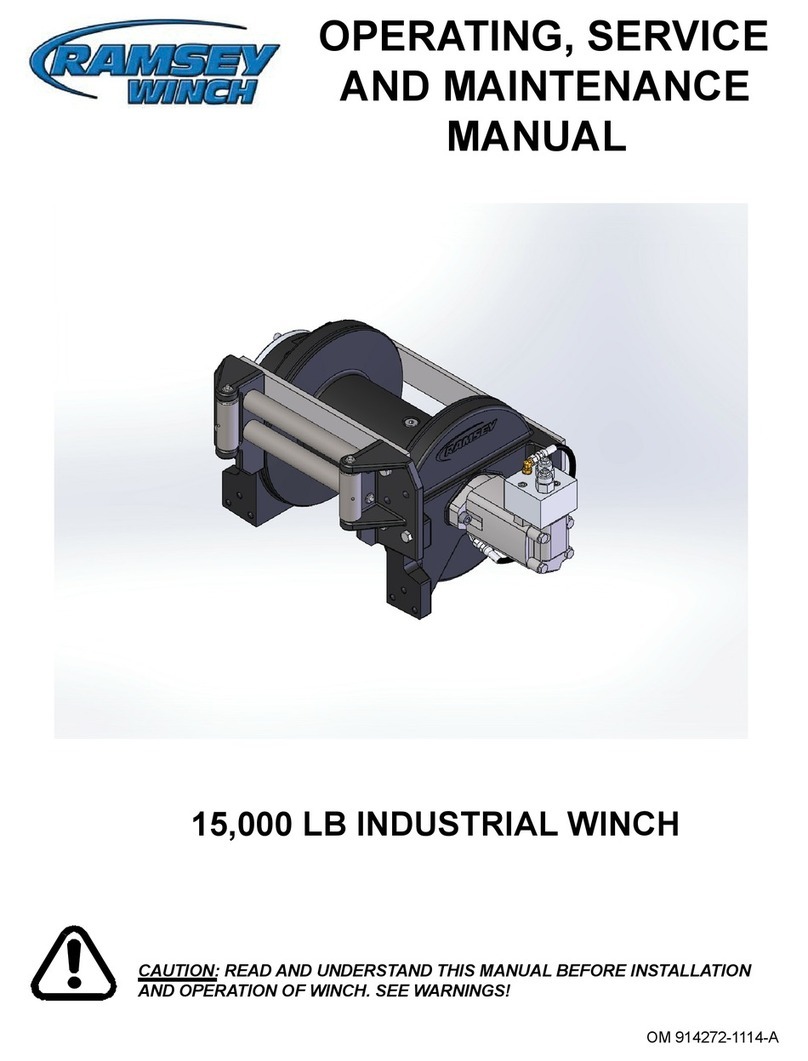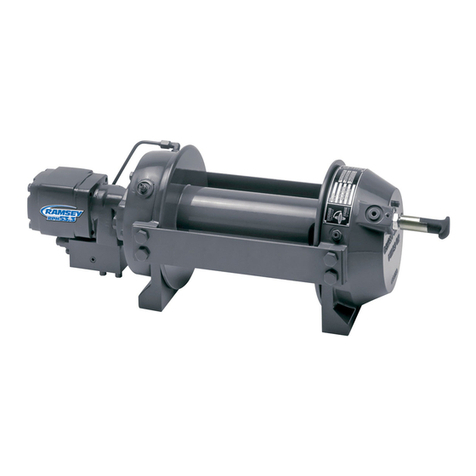
Safety Precautions To Guard Against
Possible Injury.....
A minimum of five wraps of cable around the drum
barrel is necessary to hold the rated load. Cable
clamp is not designed to hold the load.
A. Keep yourself and others a safe distance to the side of the
cable when pulling under load.
B. Do not step over a cable, or near a cable under load.
C. Use supplied hook strap when handling hook for spooling
wire rope.
D. Do not move the vehicle to pull a load on the winch cable.
This could result in cable breakage and/or winch damage.
E. Use a heavy rag or gloves to protect hands from burrs
when handling winch cable.
F. Apply blocks to wheels when vehicle is on an incline.
G. Winch clutch should be disengaged when winch is not in
use and fully engaged when in use.
H. Modification, alteration, or deviation to the winch should
only be made by Ramsey Winch Company.
I. Keep the duration of your pulls as short as possible. If
the motor becomes uncomfortably hot to the touch, stop
and let it cool for a few minutes. Do not pull more than
one minute at or near the rated load. Do not maintain
power to the winch if the motor stalls. Electric winches
are for intermittent usage and should not be used in con-
stant duty applications.
J. Disconnect the remote control switch from the winch
when not in use. A Ramsey Part No. 282053 battery dis-
connect switch in your vehicle is recommended.
K. Do Not use winch in hoisting applications due to required
hoist safety factors and features.
L. Do not exceed maximum line pull ratings shown in tables.
Shock loads must not exceed these ratings.
M. To respool correctly, it is necessary to keep a slight load
on the cable. This is accomplished by (wearing gloves)
holding the cable with one hand and the remote control
with the other, starting as far back and in the center as
you can, walking up keeping load on the cable as the
winch is powered in. Do not allow the cable to slip
through your hand and do not approach the winch too
closely. Turn off the winch and repeat the procedure until
all the cable except a few feet is in. Disconnect the
remote control switch and finish spooling in cable by
rotating the drum by hand with clutch disengaged. On hid-
den winches, spool in cable under power using supplied
hook strap.
Tips for Safe Operation
Do not underestimate the potential danger in winching opera-
tions. Neither should you fear them. Do learn the basic dan-
gers and avoid them.
The uneven spooling of cable, while pulling a load, is not a
problem, unless there is a cable pileup on one end of drum. If
this happens, reverse the winch to relieve the load and move
your anchor point further to the center of the vehicle. After
the job is done you can unspool and rewind for a neat lay of
the cable.
Store the remote control switch inside your vehicle where it
will not become damaged. Inspect it before you plug it in.
When ready to begin spooling in, plug in remote control
switch with clutch disengaged. Do not engage clutch with
motor running.
Never connect the hook back to the cable. This causes cable
damage. Always use a sling or chain of suitable strength as
shown in the illustration, page 3.
Observe your winch while winching, if possible, while stand-
ing at a safe distance. If you use vehicle drive to assist, stop
and get out every few feet to assure the cable is not piling up
in one corner. Jamming cable can break your winch.
Do not attach tow hooks to winch mounting apparatus. They
must attach to vehicle frame.
When double lining during stationary winching, the winch
hook should be attached to the chassis of the vehicle.
Since the greatest pulling power is achieved on the innermost
layer of your winch, it is desirable to pull off as much line as
you can for heavy pulls. Remember, a minimum of 5 wraps
of cable around the drum barrel is necessary to hold the rated
load.
If this is not practical, use a snatch block and double line
arrangement as shown in the illustration, page 3. Neat, tight
spooling avoids cable binding. Cable binding occurs when a
cable under load pulls down into the layer below, becoming
pinched between two other wraps of cable. If this happens,
alternately power the winch in and out a few inches. Do not
attempt to work a bound cable under load; free by hand.
2






